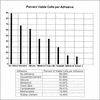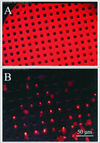Biotechnology apprenticeship for secondary-level students: teaching advanced cell culture techniques for research
- PMID: 12587031
- PMCID: PMC118370
- DOI: 10.1187/cbe.02-02-0003
Biotechnology apprenticeship for secondary-level students: teaching advanced cell culture techniques for research
Abstract
The purpose of this article is to discuss small-group apprenticeships (SGAs) as a method to instruct cell culture techniques to high school participants. The study aimed to teach cell culture practices and to introduce advanced imaging techniques to solve various biomedical engineering problems. Participants designed and completed experiments using both flow cytometry and laser scanning cytometry during the 1-month summer apprenticeship. In addition to effectively and efficiently teaching cell biology laboratory techniques, this course design provided an opportunity for research training, career exploration, and mentoring. Students participated in active research projects, working with a skilled interdisciplinary team of researchers in a large research institution with access to state-of-the-art instrumentation. The instructors, composed of graduate students, laboratory managers, and principal investigators, worked well together to present a real and worthwhile research experience. The students enjoyed learning cell culture techniques while contributing to active research projects. The institution's researchers were equally enthusiastic to instruct and serve as mentors. In this article, we clarify and illuminate the value of small-group laboratory apprenticeships to the institution and the students by presenting the results and experiences of seven middle and high school participants and their instructors.
Figures






Similar articles
-
In the students' own words: what are the strengths and weaknesses of the dental school curriculum?J Dent Educ. 2007 May;71(5):632-45. J Dent Educ. 2007. PMID: 17493972
-
Apoptosis: a four-week laboratory investigation for advanced molecular and cellular biology students.Cell Biol Educ. 2003 Winter;2(4):275-95. doi: 10.1187/cbe.03-06-0027. Cell Biol Educ. 2003. PMID: 14673493 Free PMC article.
-
Immunological tools: engaging students in the use and analysis of flow cytometry and enzyme-linked immunosorbent assay (ELISA).Biochem Mol Biol Educ. 2014 Sep-Oct;42(5):382-97. doi: 10.1002/bmb.20808. Epub 2014 Jul 23. Biochem Mol Biol Educ. 2014. PMID: 25051922
-
The University of Connecticut Biomedical Engineering Mentoring Program for high school students.Biomed Sci Instrum. 2004;40:484-90. Biomed Sci Instrum. 2004. PMID: 15134006
-
North American dental students' perspectives about their clinical education.J Dent Educ. 2006 Apr;70(4):361-77. J Dent Educ. 2006. PMID: 16595529 Review.
Cited by
-
Introducing Students of Color to Health Sciences Research: An Evaluation of the Health Disparities Summer Internship Program.J Community Health. 2018 Oct;43(5):1002-1010. doi: 10.1007/s10900-018-0505-1. J Community Health. 2018. PMID: 29623571
-
The University of Alabama at Birmingham Center for Community OutReach Development Summer Science Institute Program: a 3-yr laboratory research experience for inner-city secondary-level students.Cell Biol Educ. 2004 Fall;3(3):162-80. doi: 10.1187/cbe.03-12-0027. Cell Biol Educ. 2004. PMID: 15526064 Free PMC article.
-
Underrepresented minority high school and college students report STEM-pipeline sustaining gains after participating in the Loma Linda University Summer Health Disparities Research Program.PLoS One. 2014 Sep 24;9(9):e108497. doi: 10.1371/journal.pone.0108497. eCollection 2014. PLoS One. 2014. PMID: 25250695 Free PMC article.
References
-
- Baker J. R., Jr., Quintana A., Piehler L., Banazak-Holl M., Tomalia D., Raczka E. The synthesis and testing of anti-cancer therapeutic nanodevices. Biomed Microdev. 2001;3(1):61–69.
-
- Barab S. A., Hay K. E. Doing science at the elbows of experts: issues related to the science apprenticeship camp. J Res Sci Teaching. 2001;38(1):70–102.
-
- Bennett J. Science with attitude: the perennial issue of pupils' responses to science. School Sci Rev. 2001 Mar;82(300):59–67.
-
- Brown T. J., Jr. Using biotechnology to stimulate interest in freshman biology. Science Activities—Classroom Projects and Curriculum Ideas, Learning Science Through Exploration, 1999;36(2):31–37. - PubMed
-
- Curtis A., Wilkinson C. Topographical control of cells. Biomaterials. 1997;18:1573–1583. - PubMed
Publication types
MeSH terms
LinkOut - more resources
Full Text Sources
